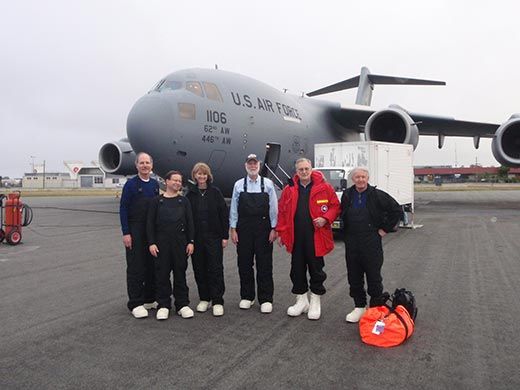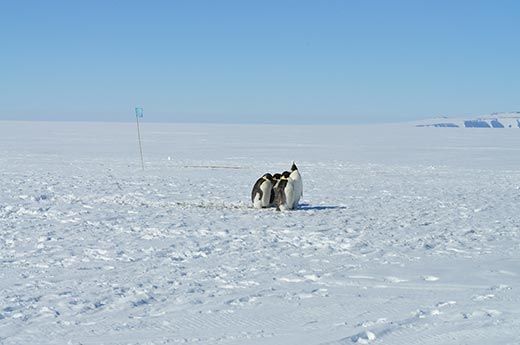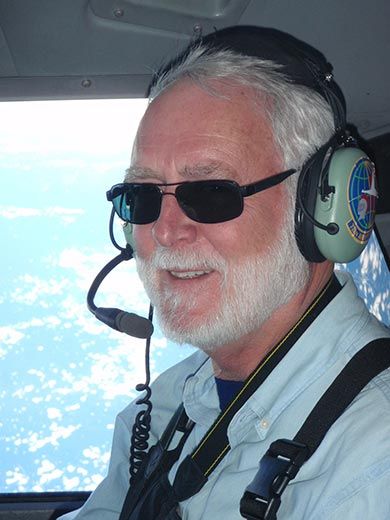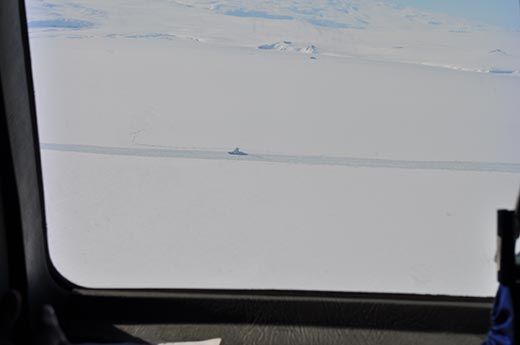Day 2: Arriving at the Spectacular Antarctic
Secretary Clough lands on a barren continent intertwined with Smithsonian history, prepared to discover the research being done
/https://tf-cmsv2-smithsonianmag-media.s3.amazonaws.com/filer/McMurdo-Station-penguins-Antarctica-631.jpg)
Jan.19, 2010, McMurdo Station, Antarctica
At 8:30 a.m. we board a large Air Force C-17 cargo plane with about 60 other people bound for the Antarctic and find ourselves in a cavernous aircraft designed for utility rather than creature comfort. Much of the space in the plane is given over to a mountain of equipment and gear with the passengers fitting around it. We take off promptly at 9 a.m. for the five-hour flight and we are hopeful of landing at McMurdo Station in Antarctica. There’s always a chance of a “boomerang” flight, where we are forced to return to New Zealand because of poor visibility at McMurdo, but for now we are optimistic.
The Smithsonian and the Antarctic have a surprisingly intertwined history. The first confirmed sightings of the planet’s fifth-largest continent didn’t occur until 1820. In 1828, Congress voted to authorize the United States Exploring Expedition, conducted by the U.S. Navy under the command of then-Lt. Charles Wilkes. From 1838 to 1842, the “Wilkes Expedition” undertook the mapping of uncharted waters and territories of interest to the United States and collected natural specimens. The route of the expedition would take it to the Antarctic where it would attempt to map the outline of the land mass. The expedition was successful and was the first to show that Antarctica is a continent. The Wilkes Expedition played a major role in development of 19th-century science, particularly in the growth of the U.S. scientific establishment. Many of the species and other items found by the expedition helped form the basis of collections at the brand-new Smithsonian Institution in 1846. A staggering number of specimens were collected during the expedition, including more than 60,000 plants, birds and sea creatures. Scientists still use these collections and now are able to explore new dimensions of them using DNA technology. This past fall, a visiting scientist at the Smithsonian identified a new species of king crab from the collection, a finding that speaks to the value of collections, and of holding them. Since the Wilkes Expedition, the Smithsonian has supported and benefitted from many more Antarctic expeditions, such as the 1947-48 expedition of Finne Ronne supported by Secretary Alexander Wetmore.
Fast forward to the 21st century and the Smithsonian continues to have a presence in the Antarctic. Our astronomers are involved in the astrophysical work that takes place at the South Pole Telescope, and the Antarctic Submillimeter Telescope and Remote Observatory was operated by the Smithsonian for some 15 years. The National Museum of Natural History houses the U.S. Antarctic Program Invertebrate Collections, which currently number 19 million specimens. Natural History is also home to the U.S. Antarctic Meteorite Program with a collection of more than 12,000 meteorite specimens from the Antarctic. We also manage the U.S. Antarctic Diving Program from the Office of the Under Secretary of Science in collaboration with the National Science Foundation. (I was offered a chance to dive under the ice on this trip, but I declined since I would have had to shave my beard. It’s been with me since 1977 and I’m rather attached to it.)
In addition to the science of the Antarctic, the Smithsonian is engaged in the work of renegotiating the historic Antarctic Treaty. As noted earlier, this important international effort, which involves both scientists and diplomats, began with a symposium at the Smithsonian last fall.
Our flight to McMurdo turns out to be without problem. In fact, the weather is clear and sunny on arrival and the views are spectacular. General Gary North, the commander of the Pacific theater for the Air Force, is on our flight and he graciously invites me to sit in the cockpit with the pilots during the approach to landing at Pegasus airport, which serves McMurdo Station and Scott Station, the New Zealand Antarctic base. The pilot notes that a sunny day here is unusual and that this is one of the most beautiful he has seen. Below lies the jigsaw puzzle of broken sea ice and glistening icebergs sailing in splendid isolation in the dark waters of McMurdo Sound. The horizon is everywhere—a white landscape rising to majestic mountain ridges. In the distance is Mount Erebus, an active volcano whose 12,000-foot peak is set off with drifting plumes of smoke rising from the molten magma that lies inside the crater. As we approach Pegasus airport we see an icebreaker working below to clear a pathway through the sea ice that blocks the way to the port. This activity is critical since the once-a-year arrival of the supply ship is only a few days away.
The C-17 smoothly loses elevation as we target the Pegasus runway—a cleared area on the continental ice sheet near McMurdo Station. A large party meets the plane to remove the supplies and greet us, while another group of warmly clad passengers awaits to board the plane for the return flight to Christchurch. The air is crisp, the sun is bright and the temperature is about 30 F. On our ride from the airport to McMurdo Station we see four Emperor Penguins standing together near the ice road as if they are waiting for someone to drop by and pick them up. As we approach them for a better look we are told that when they are molting, the penguins often just stop and wait for the process to occur.
We arrive at McMurdo Station, having passed Scott Station on our way, at about 3 p.m. Our accommodations are not opulent by any means, but are welcome. From our location we can see the peak of Observation Point where lookouts were placed to watch for the return of Robert Scott and his four-man team from their race to the South Pole in 1912. Scott and his team never did return, but perished from a combination of exhaustion, hunger and extreme cold.
McMurdo Station itself, now home to some 250 people and supporting many more at the South Pole and Palmer Station and in other areas of the Antarctic, is not designed to esthetically impress, but rather to make the work of the science teams successful. There is urgency to this effort since the time for research is short given the onset of winter.
Dinner is taken at the commissary with the many and varied constituencies who work at the station. Later an elegant reception is held for the new arrivals. NSF is kind enough to recognize the Smithsonian with a beautiful medal showing Antarctica on one side and an inscription on the other: “The Antarctic is the only continent where science serves as the principal expression of national policy and interest,” a quote issued by the White House in 1970.
As I leave the reception and begin the walk to our residence, I am reminded I am in the Antarctic, not only by the stunning setting, but also by the sun, which at 9 p.m. is still high in the sky and will not set at all tonight. Tomorrow we will don our full cold gear for an early flight to the South Pole where it is estimated the temperature will be around 30 below. We have a full round of activities slated for us and will only arrive back in McMurdo at 8 p.m., unless we are detained by weather—always a threat in this dynamic climate. I look forward to another memorable day.
Planning Your Next Trip?
Explore great travel deals
Smithsonian magazine participates in affiliate link advertising programs. If you purchase an item through these links, we receive a commission.
/https://tf-cmsv2-smithsonianmag-media.s3.amazonaws.com/accounts/headshot/wayne-clough-240.png)




/https://tf-cmsv2-smithsonianmag-media.s3.amazonaws.com/accounts/headshot/wayne-clough-240.png)